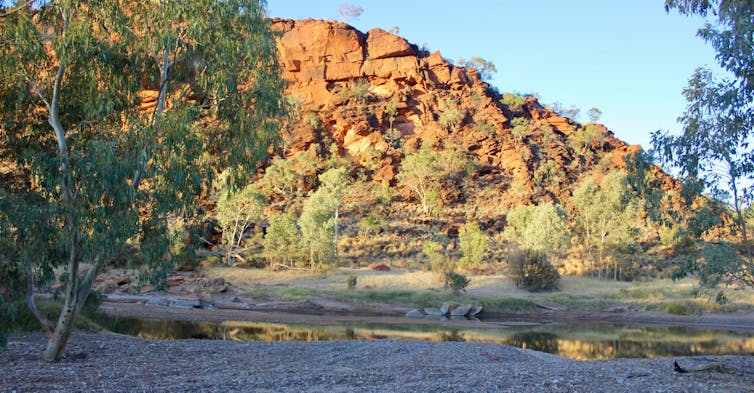Desert rainbowfish: how they survive in Australia’s scorching desert

A trip into central Australia involves packing your 4WD to the brim with survival gear, water and food. Yet fish have managed to persist in that parched landscape for thousands of years – how do they do it?
We at the Flinders Molecular Ecology Lab went about finding out. Our recent research examined rainbowfish in Australia, to discover how they hold onto life in isolated pockets of water in the desert.
Pockets of water in the desert can only hold small fish populations. A small population means a small gene pool – which can lead to inbreeding and poor health, as we sometimes see in endangered species.
But we found even small populations can adapt to the harsh environments of water holes and small creeks. Life finds a way – even in one of the most extreme and unpredictable environments on Earth.
Prospering in central Australia
Native desert rainbowfish (Melanotaenia splendida tatei) live in the deserts of central Australia. They grow to about 9cm and are usually silver and iridescent, with a yellow and green chequered pattern on the fins.
Desert rainbowfish populations live in slow-flowing and still habitats, including impermanent rivers, waterholes, lakes, flowing bores and stock dams.
Their populations fluctuate during boom-bust cycles. During rare flooding events in the desert, rainbowfish breed in large numbers and spread along temporary streams and floodwaters.
Our findings
Our research sought to determine how rainbowfish populations persist in desert regions of central Australia, and whether their genomes show evidence of adaptation to the local harsh conditions.
We collected 344 desert rainbowfish from 18 rivers and waterholes from across the vast and arid Lake Eyre Basin, and from semi-arid regions of the Murray-Darling Basin.
We then compared the variation in the genomes of these fish with data from satellite images about the presence of surface water in central Australia.
We found that natural selection in rainbowfish is stronger in regions of the desert that have drier conditions. Fish from the very arid western region of central Australia adapt differently to dry conditions than those from the semi-arid eastern region.
We also found these gene variations are carried by the fish as they disperse during the floods. The fish that were pre-adapted to very harsh conditions retreated with the floodwaters to wait out the often extended drought periods in small, isolated waterholes.
This suggests genes adapted to the most arid conditions may help small populations to persist in harsh environments. These adaptations might also help the species persist in future climates, which are expected to become drier and with more extreme events.
The most intriguing adaptive difference involved a mutation in a gene coding which leads to some fish producing a slightly different guanine nucleotide-binding protein. Fish use these proteins for taste and smell, to detect salinity and water flow, and to control light sensitivity for vision.
Rainbowfish in Central Australia may survive the harsh conditions because of this difference in the protein and other adaptations. This would improve their ability to sense the environment and how it varies across seasons.
The variation can be compared to the recent Omicron COVID-19 variant. Research has found mutations in the spike protein in some variants may aid its spread among humans.

Looking ahead
Our research found the genetic variation can be maintained in small rainbowfish populations to allow the species to survive in the desert.
The findings suggest that the population size of desert rainbowfish, at least during very dry periods of the year, is less than that commonly thought necessary in nature for species conservation and for adaptation to future climate changes. This turns on its head traditional thinking that small populations are evolutionary dead ends.
As climate change worsens, our findings highlight the importance of conserving natural river flows to enable freshwater species to respond and adapt.![]()
Catherine R. M. Attard, Lecturer in Molecular Ecology, Flinders University; Chris Brauer, Postdoctoral Fellow Molecular Ecology Lab, Flinders University; Jonathan Sandoval Castillo, Postdoctoral Fellow Molecular Ecology, Flinders University; Louis Bernatchez, Professeur en biologie, Université Laval; Luciano Beheregaray, Professor of Biodiversity Genomics, Flinders University, and Peter Unmack, Research Fellow, University of Canberra
This article is republished from The Conversation under a Creative Commons license. Read the original article.

